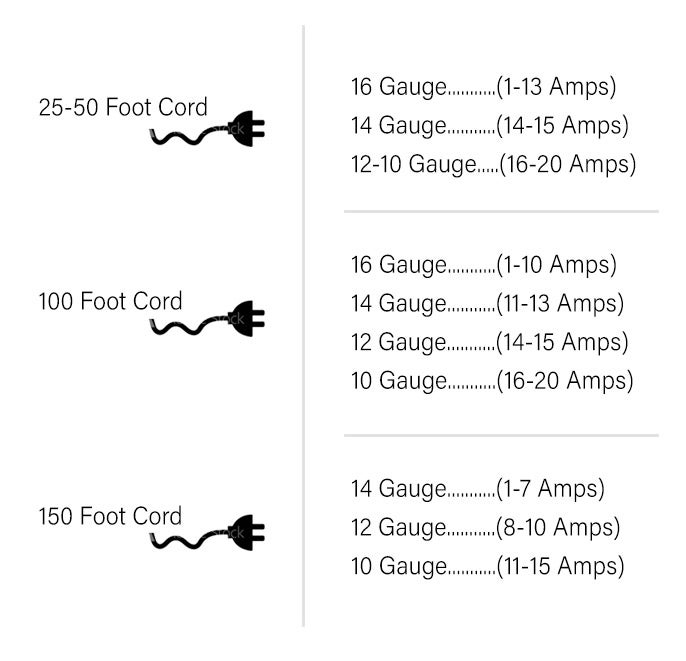
When you need an extension cord, it is common to rummage through the closet or junk drawer and grab the first one your find, but it’s not that simple. Choosing the wrong extension cord can lead to electrical fires, shock, and poor device performance. This guide covers everything you need to know to avoid this by choosing the right extension cord for the job.
Need an Extension Cord? Consider These 4 Factors First
- Location of Use - Where are you using this cord - indoors, outdoors, or both?
- Plug Type - What type of plug and outlet are you connecting to - 2-prong or 3?
- Max Amperage - How power will the connected device require?
- Length - How long of a cord do you need to reach the nearest outlet.
Below, learn more about these four factors and why they are so important.
Location of Use - Indoor vs. Outdoor Extension Cords
For utmost safety and efficiency, it is important to consider where and how you will be using the extension cord. Though an outside extension cord may be used inside, an inside extension cord should never be used outside, as they are simply not made for it.
Indoor Extension Cords
- Not designed to be exposed to weather, extreme temperatures, or rough terrain
- Thinner with less durable casing
- Shorter in length
- Accommodate less wattage
- Deliver less power
- Best for smaller tools and household appliances
Outdoor Extension Cords
- Thicker with rugged insulation to hold up to weather, temperature, and terrain
- Available in longer lengths
- Designed to accommodate more wattage
- Deliver more power
- Best for larger and higher amperage tools
How to Choose: Look for the Letter
Once you know where and how you will be using your cord, look for a designation letter(s) on the cord’s jacket. The letter indicates what the cord should be used for, helping you choose the right one.
S: For general use
W: Rated for outdoor use
J: 300-volt insulation service cord
P: Parallel wire construction (household extension cord)
T: Vinyl thermoplastic cord jacket
E: Thermoplastic elastomer rubber cord jacket
O: Oil-resistant cord
FT2: Flame retardant cord
CL2S: Wire is designed for in-wall construction
SRDT: Wire is heavy duty and good for high amperage tools and devices
HPN: Will perform with high temperature appliances
Plug Type - 2-Prong vs. 3-Prong Extension Cords
Standard extension cords are available in 2-prong or 3-prong models.
2-Prong (Non-Grounded): 2-blades designed to fit into 2-slot outlets, often used in older homes with dated wiring
3-Prong (Grounded): 2 blades and 1 grounding pin for use with modern 3-prong electrical outlets
3-prong extension cords reduce the risk of electrical fire and shock. They should be used whenever possible, but can only be used with 3-prong outlets. If your space has dated wiring and outlets, a 2-prong extension cord will be required. Though separate 3-prong adapters are a fairly safe short-term solution, it is not recommend you use them with extension cords.
Max Amperage and AWG Basics
Extension cords have a max amount of amperage, or power, they can safely handle. It is important to not overload your cord, as it can overheat and catch fire. The AWG (American Wire Gauge) - rating will help you choose the proper cord. In simple terms:
The lower the AWG, the thicker the wire, and the higher the amperage capacity.
The higher the AWG, the thinner the wire, and the lower the amperage capacity.
Gauge rating refers to the diameter of the conductors within the extension cord. Common gauge ratings range from 16-gauge (smallest) to 10-gauge (largest). Gauge rating is often listed along with the number of conductors in the wire. For example, a 16/3 extension cord consists of (3) 16-gauge conductors.
Here are some common gauge ratings and their uses:

Extension Cord Length
Length is the final factor in choosing the right extension cord for the job. Length and gauge rating work together to accurately determine an extension cord’s capacity.
The longer a cord is, the less power it can deliver to your device.
For optimal device performance and energy efficiency, only go as long as you need.
A longer extension cord will deliver less power to your device than a shorter cord of the same gauge. Consult the chart below for examples.

Learn more: Extension Cord Safety Tips to Prevent Fire and Shock
